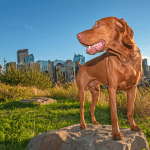Are You Making These Dog Training Mistakes?
Training your dog is an important aspect of responsible ownership. Having a well behaved dog has benefits for owners and other people and pets in society. Training with your dog creates a stronger bond and provides him, or her, with essential mental stimulation and enrichment. However, dog training can be a minefield at times. Read our Holidays4Dogs article to find out if you are making these dog training mistakes.
But do we always get it right? We all know the best laid plans don’t always turn out how we expected. Dog training isn’t necessarily hard to do if you have a little knowledge and a good deal of patience. However, there are a few common mistakes which are easily made and can hamper progress when training your dog.
Bribery.
This is one of the most common dog training mistakes. Training with food is one of the best ways to train new behaviours with your dog. But, using food as bribery, rather than a reward your dog, is an easy mistake to get into. There is a distinct difference.
Bribery is an attempt to get your dog to do something, almost by deceit. For example, offering your dog a treat because he won’t come in from the garden. A reward, however, tells your dog, “Yes! – You just did a really good job”.
Time and Patience.
It essential to put aside time to train your dog on a regular basis. Think about what you want to achieve before you begin, so that you understand the training procedure needed. Some more challenging training projects, such as teaching your dog intricate obedience exercises will take time. Likewise, discouraging him from chasing the neighbour’s cat, could take months to achieve, using classical conditioning techniques.
Therefore, patience is key. Believing that dog training involves a quick fix is, quite frequently, a mistake made by many dog owners.
Always end training sessions on a good note and if you feel you are not getting anywhere at a particular time, stop and try again another time. It is a mistake to allow yourself to become angry with your dog, because he doesn’t seem to understand. Have a think about how you might be confusing your dog and begin again another day.
Anticipation and Timing.
Learning to anticipate your dog’s next move is a skill you need to try and develop in dog training. In doing so, you will get faster results. Rather than react to your dog after the event, try and begin to read his body language. Anticipating what he might do next, makes your training more effective.
In doing so, you will get faster results. Rather than react to your dog after the event, try and begin to read his body language. Anticipating what he might do next, makes your training more effective.
For example, rather than correcting your dog for non-stop barking at the door, try and watch him and react to his signals before he starts the full blown behaviour.
In other words, at the point when he is just thinking about it. He may jump up, twitch his ears, or growl – all these signs could be interrupted, before he gets to the stage of throwing himself at the front door.
In such scenarios, you will find it so much more difficult to control his behaviour and training may be more challenging as a result. Once your dog is already over-aroused, or in full flight, you might be tempted to shout, or grab him. However, this is quite likely to increase the intensity of his response. Try and intervene positively before he reaches that stage.
If you have difficulty with timing your rewards, get started with clicker training – it’s ideal for novice handlers and dogs. The clicker tells the dog the exact moment he has done the correct behaviour and that a treat is coming. Its easy to learn and results are fast – especially good for all the basic cues, as well as more complex behaviour issues.
Generalising Training too soon.
One of the most frequent from owners attending training classes, – (usually as their dog bolts round the training hall with deaf ears! ) – is, “but he does it at home”.
Training your dog to sit, stay, or come when called at home, might be successful. However, this does not mean he will do the same in a different environment, or under distraction. Yes, it is really important to begin training new behaviours in a quiet and familiar environment. However, once he understands, slowly introduce distractions.
Eventually, you can be reasonably sure he will do as you ask, in all sorts of situations. But always make sure you gradually increase distractions. Once your dog is reliably coming back when called at home, don’t jump to trying it while your dog is playing with others in the park – grade distractions up slowly.
Repeating Requests.
One of the more common mistakes made by trainers is constantly repeating commands (cues). If you have to ask your dog to, “sit, sit, sit, sit, SIT!!” and he only sits on the fifth command you are effectively teaching him to stall his response. In the beginning, you can lure your dog. Hold a treat above his head, as soon as his bottom touches the floor say “sit” and then praise. 
If your dog ignores you when you ask him to do something, he either does not understand the command, or he is too distracted. By nagging your dog, you are ultimately teaching him to be unreliable and to ‘zone out’ of your incessant requests!
Consistency.
Try to be consistent towards your dog. Remember which cue words you want to use and stick to them. If one minute you ask your dog to “sit” and the next ask him to “sit down” this may cause confusion.
If you are able to stay patient one day, but then lose your cool the next, your dog may become unsettled by your unpredictability. They may start to feel nervous about how to behave around you. Keep cool, calm and consistent at all times.
Blaming the dog.
It is very easy to blame the dog for any lack of progress when it comes to training. However, try to remember you are his human teacher and he is a dog. Try and see things from his point of view.
Dogs are not stupid, or naughty – they are, in fact, very good at learning very complex behaviours, but dogs are not human. There are specific and scientific ways in which to do this. It is crucial that any training methods are reward based and positive. Aversive, harsh treatment will almost certainly destroy your chances of successfully training your dog. It will also eradicate the chance of ever creating a strong bond.
Always remember to give your dog a break and cut him some slack from time to time. Dogs will be dogs – and will naturally behave in species appropriate ways – (even if that doesn’t always fit our agenda). With this in mind, you will forge a much better understanding and relationship with your loyal friend.
If you need further help with your dog’s behaviour, contact your vet for referral to a behaviourist or sign up to one of our pet courses. For training clubs, contact the Kennel Club.


